
Hurricane Edith was the strongest hurricane to form during the 1971 Atlantic hurricane season and the southernmost landfalling Category 5 hurricane on record in the Atlantic at the time. Edith developed from a tropical wave on September 5 and quickly strengthened into a hurricane in the Caribbean Sea. Edith rapidly intensified on September 9 and made landfall on Cape Gracias a Dios as a Category 5 hurricane on the Saffir-Simpson Hurricane Scale. Being a category 5 hurricane, Edith peaked at only 943 mbar (hPa), making Edith the least intense category 5 Atlantic hurricane on record. It quickly lost intensity over Central America and after briefly entering the Gulf of Honduras it crossed the Yucatán Peninsula in Mexico. After moving across the Gulf of Mexico a trough turned the storm to the northeast and Edith, after having restrengthened while accelerating towards the coast, made landfall on Louisiana with winds of 105 mph (169 km/h) on September 16. Edith steadily weakened over land and dissipated over Georgia on September 18.

Tropical Storm Tammy was a short-lived tropical storm during October in the 2005 Atlantic hurricane season which caused minor damage to the southeastern United States. More significant, however, were its remnants, which contributed to the Northeast U.S. flooding of October 2005.

Hurricane Cindy was a tropical cyclone that briefly reached minimal hurricane strength in the Gulf of Mexico during July in the 2005 Atlantic hurricane season and made landfall in Louisiana. It was the third named storm and first hurricane of the season. Cindy was originally thought to have been a tropical storm at peak strength, but was upgraded to a Category 1 hurricane in the post-season analysis. Cindy formed on July 3 just east of the Yucatán Peninsula in the Caribbean Sea. The depression soon made landfall on the peninsula and weakened before reemerging in the Gulf of Mexico on July 4. The storm strengthened as it moved north becoming a hurricane just before making landfall near Grand Isle, Louisiana, on July 5. The storm weakened as it moved overland and became extratropical on July 7.

Hurricane Danny was the only hurricane to make landfall in the United States during the 1997 Atlantic hurricane season, and the second hurricane and fourth tropical storm of the season. The system became the earliest-formed fifth tropical or subtropical storm of the Atlantic season in history when it attained tropical storm strength on July 17, and held that record until the 2005 Atlantic hurricane season when Tropical Storm Emily broke that record by several days. Like the previous four tropical or subtropical cyclones of the season, Danny had a non-tropical origin, after a trough spawned convection that entered the warm waters of the Gulf of Mexico. Danny was guided northeast through the Gulf of Mexico by two high pressure areas, a rare occurrence in the middle of July. After making landfall on the Gulf Coast, Danny tracked across the southeastern United States and ultimately affected parts of New England with rain and wind.
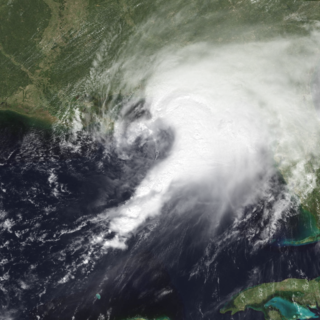
Hurricane Earl was an atypical, disorganized, and short-lived Category 2 hurricane that caused moderate damage throughout the Southeast United States. It formed out of a poorly organized tropical disturbance over the southwest Gulf of Mexico late on August 31, 1998. Tracking towards the northeast, the storm quickly intensified into a hurricane on September 2 and made landfall early the next day near Panama City, Florida. Rapidly tracking towards Atlantic Canada, the extratropical remnants of Earl significantly intensified before passing over Newfoundland on September 6. The remnants were absorbed by former Hurricane Danielle two days later.

Accompanying Hurricane Katrina's catastrophic coastal impacts was a moderate tornado outbreak spawned by the cyclone's outer bands. The event spanned August 26–31, 2005, with 57 tornadoes touching down across 8 states. One person died and numerous communities suffered damage of varying degrees from central Mississippi to Pennsylvania, with Georgia sustaining record monetary damage for the month of August. Due to extreme devastation in coastal areas of Louisiana and Mississippi, multiple tornadoes may have been overlooked—overshadowed by the effects of storm surge and large-scale wind—and thus the full extent of the hurricane's tornado outbreak is uncertain. Furthermore, an indeterminate number of waterspouts likely formed throughout the life cycle of Hurricane Katrina.

Tropical Storm Bill was a tropical storm that affected the Gulf Coast of the United States in the summer of 2003. The second storm of the 2003 Atlantic hurricane season, Bill developed from a tropical wave on June 29 to the north of the Yucatán Peninsula. It slowly organized as it moved northward, and reached a peak of 60 miles per hour (97 km/h) shortly before making landfall in south-central Louisiana. Bill quickly weakened over land, and as it accelerated to the northeast, moisture from the storm, combined with cold air from an approaching cold front, produced an outbreak of 34 tornadoes. Bill became extratropical on July 2, and was absorbed by the cold front later that day.
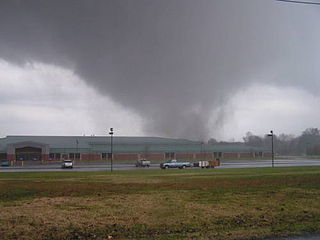
This page documents notable tornadoes and tornado outbreaks worldwide in 2005. Strong and destructive tornadoes form most frequently in the United States, Bangladesh, Argentina, Brazil and Eastern India, but they can occur almost anywhere under the right conditions. Tornadoes also develop occasionally in southern Canada during the Northern Hemisphere's summer and somewhat regularly at other times of the year across Europe, Asia, and Australia. Tornadic events are often accompanied with other forms of severe weather, including strong thunderstorms, strong winds, and hail.
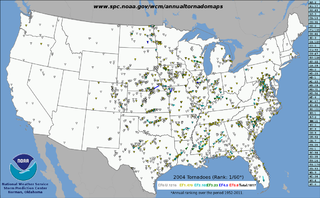
This page documents notable tornadoes and tornado outbreaks worldwide in 2004. Strong and destructive tornadoes form most frequently in the United States, Bangladesh, and Eastern India, but they can occur almost anywhere under the right conditions. Tornadoes also develop occasionally in southern Canada during the Northern Hemisphere's summer and somewhat regularly at other times of the year across Europe, Asia, and Australia. Tornadic events are often accompanied with other forms of severe weather, including strong thunderstorms, strong winds, and hail.
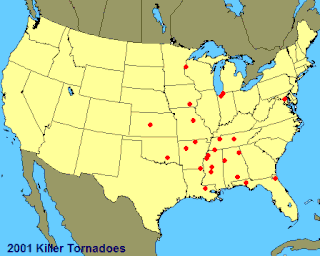
This page documents notable tornadoes and tornado outbreaks worldwide in 2001. Strong and destructive tornadoes form most frequently in the United States, Bangladesh, and Eastern India, but they can occur almost anywhere under the right conditions. Tornadoes also develop occasionally in southern Canada during the Northern Hemisphere's summer and somewhat regularly at other times of the year across Europe, Asia, and Australia. Tornadic events are often accompanied with other forms of severe weather, including strong thunderstorms, strong winds, and hail.

The Hurricane Ivan tornado outbreak was a three-day tornado outbreak that was associated with the passage of Hurricane Ivan across the Southern United States starting on September 15, 2004, across the Gulf Coast states of Alabama and Florida as well as southern Georgia before ending in the Middle Atlantic Coast on September 18.
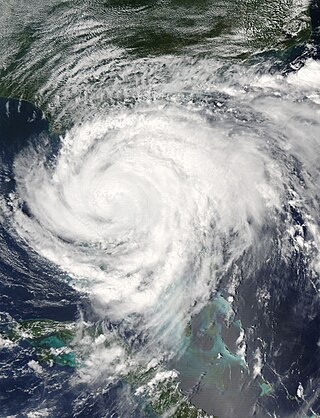
The Hurricane Frances tornado outbreak was a widespread tornado outbreak associated with Hurricane Frances that came ashore on eastern Florida on September 4–5, 2004. Outer bands from the hurricane and its remnants, when it moved across the Appalachian Mountains, produced one of the largest tornado outbreaks ever spawned by a tropical cyclone in the United States in terms of number of tornadoes confirmed since records were kept in 1950. In addition, it was the largest tornado outbreak in South Carolina history, with nearly half of the tornadoes in that state.
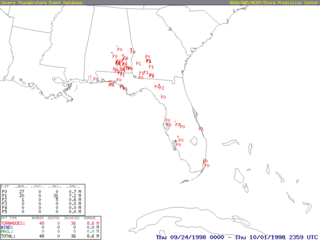
The 1998 Hurricane Georges tornado outbreak was a six-day tornado outbreak associated with the passage of Hurricane Georges in the Southeast United States. Most of the tornadoes produced by the storm formed in the outer bands of the storm and were relatively weak; however, one F2 tornado touched down in Florida. The outbreak produced 47 tornadoes—20 in Alabama, 17 in Florida and 10 in Georgia—and was the most extensive tornado event in Florida history, with touchdowns reported the entire length of the state.

This page documents the tornadoes and tornado outbreaks of 1996, primarily in the United States. Most tornadoes form in the U.S., although some events may take place internationally. Tornado statistics for older years like this often appear significantly lower than modern years due to fewer reports or confirmed tornadoes, however by the 1990s tornado statistics were coming closer to the numbers we see today.

This page documents the tornadoes and tornado outbreaks of 1954, primarily in the United States. Most tornadoes form in the U.S., although some events may take place internationally. Tornado statistics for older years like this often appear significantly lower than modern years due to fewer reports or confirmed tornadoes.

The first six days of December 1953 produced a destructive and deadly tornado outbreak sequence across the Southern United States. There were 19 confirmed tornadoes, including a violent F4 tornado that hit the northwest side of Alexandria, Louisiana and even more violent F5 tornado that hit Vicksburg, Mississippi. In all, the tornadoes killed 49 people, injured 404 others, and caused $45,709 million in damage. The death toll made this deadliest December tornado outbreak ever recorded and it would not be surpassed until 2021. This was also the last of the series of deadly and catastrophic tornado outbreaks to strike the US in 1953.
A destructive and deadly tornado outbreak tore through Eastern Alabama and Western Georgia during the afternoon of December 5, 1954. A total of 14 tornadoes were confirmed, 10 of which were significant (F2+), including one that hit Metro Atlanta. Two people were killed, 125 others were injured, and damages total $2.710 million.

Hurricane Carla triggered a destructive and deadly outbreak of 21 tornadoes in Alabama, Louisiana, Texas, Arkansas, and Michigan that occurred from September 10–13, 1961. A total of 11 tornadoes touched down in Louisiana, and eight more in Texas. The strongest tornado of the outbreak was a 1 mile (1.6 km) long, 100 yards (91 m) wide F4 tornado that moved across Galveston Island in the early morning hours of Tuesday, September 12, 1961, killing eight people. This was the first of only two known violent tornadoes ever spawned by a hurricane with the other one happening during Hurricane Hilda in 1964. By the time it was over, the outbreak had killed 14 people, injured 337 others, and caused over $3.461 million in damage.

















